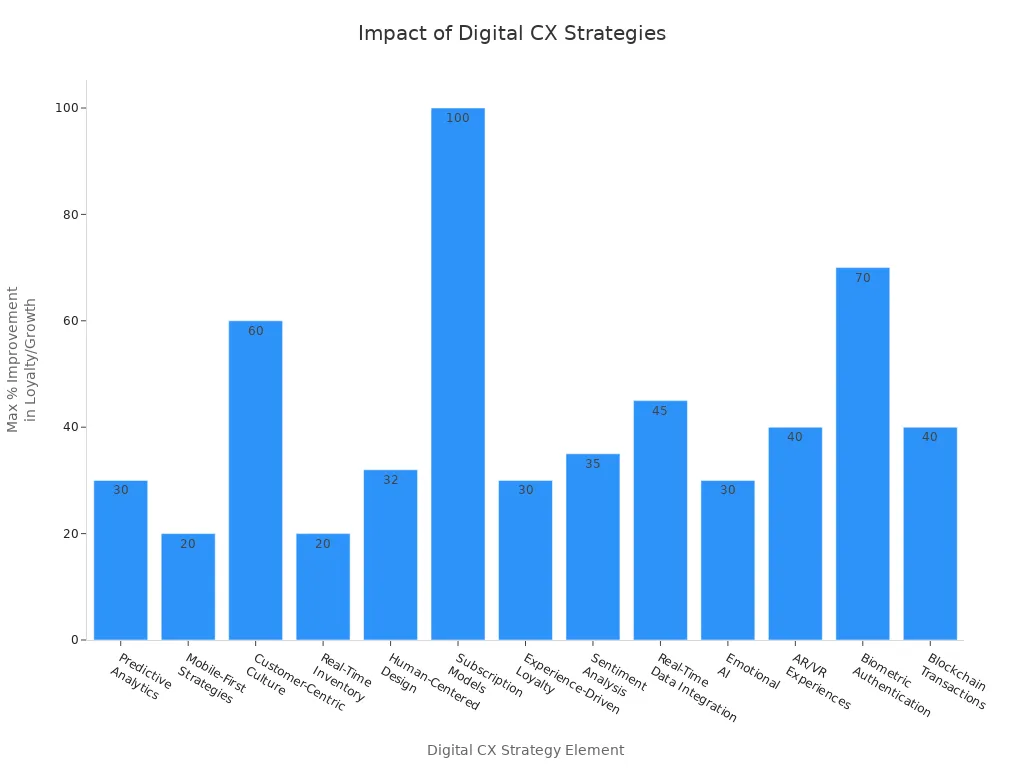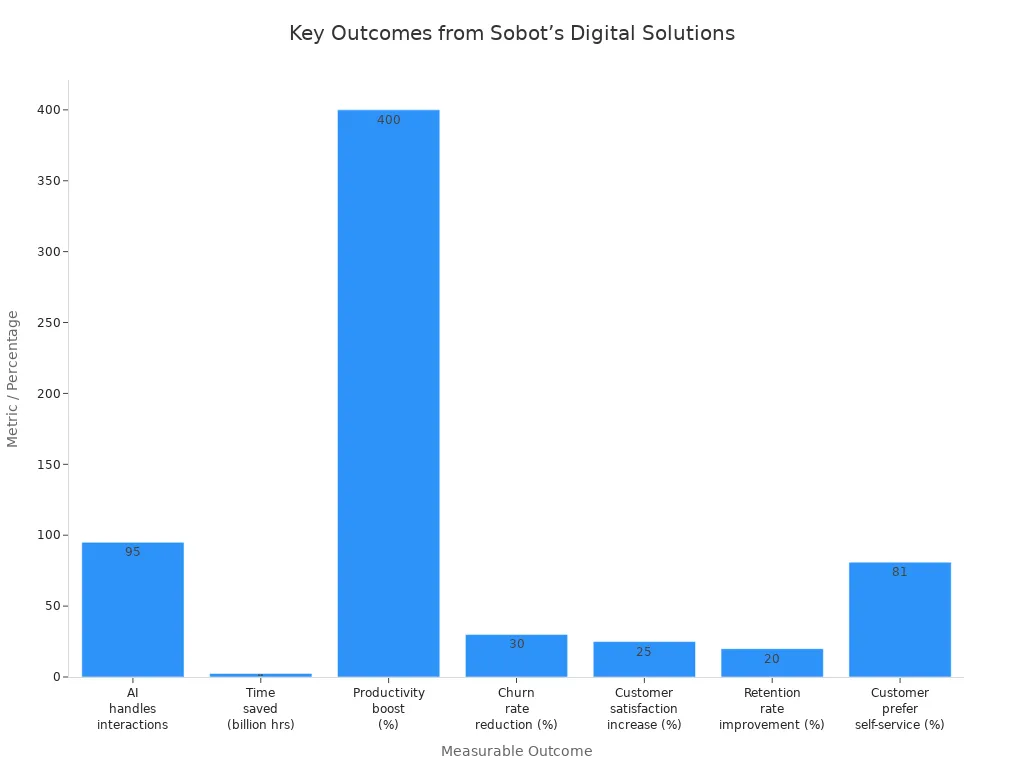Digital customer experience strategy and its impact on loyalty

A digital customer experience strategy shapes how companies connect with customers online. Today, businesses see digital customer experience as a top priority.
- 54% of digital transformation efforts focus on modernizing customer touchpoints.
- Over 80% of companies now invest in omnichannel experience strategies.
- 62% of customers prefer personalized experiences, and 70% expect brands to know their history.

A strong digital customer experience strategy increases customer loyalty and helps businesses grow. Sobot and Sobot AI provide all-in-one solutions that help brands deliver seamless customer experiences across every channel.
Digital customer experience strategy

What is digital customer experience?
Digital customer experience describes how people interact with a brand through digital channels. This includes websites, mobile apps, social media, chatbots, and email. Industry experts define a digital customer experience strategy as a comprehensive plan that optimizes every digital touchpoint. The goal is to create a seamless journey for the customer by removing friction and making each interaction easy and enjoyable. Companies use feedback, analytics, and tools like surveys and heatmaps to monitor and improve these experiences. A strong digital customer experience strategy puts the customer at the center. It uses technology and data to deliver personalized, efficient, and consistent service. This approach helps businesses build loyalty and drive growth in a world where most interactions now happen online.
Digital customer experience differs from traditional customer experience. Traditional methods rely on face-to-face meetings and personal relationships. Digital strategies focus on speed, convenience, and personalization. For example, only 28% of sales now involve in-person talks, showing a shift to digital channels (source). Digital customers expect quick answers and personalized service. Companies use AI chatbots and data analytics to meet these needs. This shift saves costs and allows businesses to scale faster.
| Aspect | Traditional Customer Experience | Digital Customer Experience |
|---|---|---|
| Customer Engagement | Personal touch, face-to-face, trust through people. | Automated tools, AI chatbots, fast and scalable service. |
| Scalability | Local teams, high cost, slow to expand. | Cloud-based, global reach, rapid growth. |
| Cost Structure | High costs, large teams, in-person support. | Automation, fewer workers, optimized spending. |
| Adaptability | Fixed rules, slow to change. | Real-time data, quick updates, continuous improvement. |
| Challenges | N/A | Privacy, tech integration, risk of less personal touch. |
Key elements of a strategy
A successful digital customer experience strategy includes several important parts. Research shows that 70% of buying decisions depend on how customers feel treated. Personalization matters, as 88% of shoppers continue their journey if the experience feels tailored to them. An omnichannel approach is also critical because customers switch between channels to find information and solve problems. Poor experiences can cost businesses trillions each year.
- Understanding the Customer Journey: Companies map every touchpoint to find pain points and opportunities.
- Personalization at Scale: AI and machine learning help deliver relevant and timely experiences.
- Omnichannel Integration: Customers get consistent service across websites, apps, chat, and more.
- Data-Driven Decision Making: Analytics and KPIs track performance and guide improvements.
- Continuous Improvement and Innovation: Businesses update their strategy to match changing needs.
- Technology Infrastructure: Integrated platforms support personalization, analytics, and security.
- Organizational Alignment: Teams work together to keep the customer at the center.
Tip: Companies that use these elements see higher satisfaction, loyalty, and better business results.
Many technologies support digital customer experience strategies:
- Customer journey analytics and session replay tools
- Heatmaps and interaction maps
- AI-powered chatbots with natural language processing
- Mobile-first web optimization
- Unified communications platforms for seamless omnichannel engagement
- Social media integration
- Cloud management tools for global service
- Generative AI for real-time content personalization
Transparency about AI data use helps build trust with customers.
Sobot’s approach
Sobot offers a complete solution for digital customer experience. The company provides an all-in-one contact center platform that supports voice, live chat, chatbot, ticketing, and WhatsApp API. Sobot’s tools help businesses deliver seamless and personalized experiences across every channel. The platform uses AI to automate routine tasks, freeing agents to handle complex issues. Sobot’s unified workspace gives agents a full view of each customer, making service faster and more personal.
Sobot’s impact is clear. Businesses using Sobot’s digital customer experience solutions have seen measurable results:
| Measurable Outcome | Description / Impact | Metric / Percentage |
|---|---|---|
| AI handling customer interactions | AI projected to handle 95% of all customer interactions by 2025 | 95% by 2025 |
| Time saved | Automation and AI tools save businesses up to 2.5 billion hours annually | 2.5 billion hours annually |
| Productivity boost | AI-powered tools increase business productivity | Up to 400% |
| Churn rate reduction | Proactive AI customer service reduces customer churn | Up to 30% reduction |
| Customer satisfaction increase | AI-driven proactive service improves satisfaction | Up to 25% increase |
| Retention rate improvement | Proactive interventions improve customer retention | Up to 20% increase |
| Customer preference for self-service | Customers prefer self-service options supported by AI | 81% prefer self-service |
| Support availability | AI tools provide 24/7 customer support | 24/7 support |

Sobot’s platform helps companies in retail, finance, gaming, and more. For example, OPPO used Sobot’s chatbot and ticketing system to handle high volumes of customer inquiries. This led to an 83% chatbot resolution rate and a 57% increase in repurchase rate. Sobot’s solutions support digital transformation by making customer experience more efficient and effective. The company’s focus on innovation, customer-centricity, and efficiency helps brands build loyalty and grow.
Customer journey and loyalty

Mapping the digital customer experience journey
Mapping the digital customer experience journey helps businesses understand how people interact with their brand from start to finish. This process shows every step a customer takes, from first learning about a product to becoming a loyal supporter. Companies use journey maps to spot problems, improve touchpoints, and make the experience smoother.
The key stages in a digital customer experience journey include:
- Awareness: Customers first discover the brand or product through ads, social media, or word of mouth.
- Interest: They look for more information and engage with content to learn about what the brand offers.
- Consideration: Customers compare options and think about whether the brand meets their needs.
- Intent: They decide to buy, influenced by price, reviews, and how well the product fits their expectations.
- Purchase: The transaction happens, and a smooth process is important.
- Use: Customers interact with the product or service, shaping their overall experience.
- Retention: Brands work to keep customers happy and engaged after the purchase.
- Advocacy: Satisfied customers recommend the brand to others and share positive feedback.
Mapping the customer journey gives companies a clear view of where customers face challenges. It also helps teams work together to fix issues and create a cohesive customer journey.
Businesses often use different types of journey maps, such as Current State Maps to find pain points, Future State Maps to plan improvements, and Persona-Based Maps to tailor experiences for different customer groups. These tools help companies deliver a better digital customer experience and meet customer expectations at every stage.
Touchpoints and consistency
Touchpoints are the moments when customers interact with a brand during their digital customer experience journey. These can include social media, online ads, websites, live chat, product reviews, customer support, and loyalty programs. Each touchpoint shapes how customers feel about the brand.
The most critical digital touchpoints in a typical customer journey are:
- Social media posts and ads
- Digital marketing content like videos and blogs
- Ecommerce platforms and product pages
- Live chat and AI-powered customer support
- Product reviews and ratings
- Customer onboarding and success programs
- Loyalty programs and rewards
- Self-service resources such as knowledge bases
Consistency across all these touchpoints is key. When customers get the same quality of service and messaging everywhere, they feel more confident and trust the brand. Research shows that customers who experience consistent service are twice as likely to return and recommend the brand to others. Inconsistent experiences can lead to frustration and damage the brand’s reputation.
Companies that use an omnichannel approach, like Sobot’s omnichannel solution, create a seamless experience by connecting all digital and offline touchpoints. This unified strategy helps brands meet customer expectations and build stronger relationships.
Sobot’s platform brings together channels like voice, chat, email, and social media into one workspace. This makes it easier for agents to deliver fast, personalized, and consistent service, no matter where the customer starts their journey.
Impact on loyalty
A well-mapped digital customer experience journey leads to higher customer loyalty. When companies understand and improve each step, customers feel valued and understood. This reduces frustration and makes them more likely to stay with the brand.
Mapping the customer journey helps businesses:
- Find and fix pain points that cause customers to leave
- Personalize experiences based on real needs
- Align teams around a single view of the customer
- Make smarter decisions that boost satisfaction and retention
Brands that invest in journey mapping see higher retention rates. For example, a financial services firm increased customer retention by 20% after using journey mapping to improve digital touchpoints. According to Aberdeen Group, companies with strong journey management get a 54% greater return on marketing investment (source).
Sobot’s omnichannel communication platform gives businesses the tools to map and optimize every touchpoint. OPPO, a global smart device brand, used Sobot’s solution to connect all customer channels and automate support with AI. After the change, OPPO saw a 57% increase in repurchase rate and an 83% chatbot resolution rate. Over 90% of OPPO’s customers reported a positive experience with the AI-powered service, showing a direct link between a cohesive customer journey and improved customer loyalty.
A seamless digital customer experience journey, powered by an omnichannel approach, helps brands exceed expectations and turn satisfied customers into loyal advocates.
Personalization and omnichannel strategy
Personalization in digital customer experience
Personalization shapes how customers feel about a brand. Recent research shows that 64% of consumers prefer to buy from brands that personalize experiences. Brands dedicate over half of their marketing budgets to personalization. They use customer data from ecommerce, CRM, and loyalty apps to create unified profiles. This helps them deliver personalized offers, targeted emails, and relevant content. For example, Mizzen+Main increased retail revenue by 27% by using a single customer view. Two-thirds of consumers choose brands that anticipate their needs. Personalized rewards in loyalty programs matter, with 73% of shoppers wanting them. However, only 45% of brands provide these rewards. Brands must balance personalization with privacy. Over half of consumers worry about data privacy, so companies need to use consent-based messaging and transparent data practices. Personalisation, when done right, increases loyalty, satisfaction, and order value.
Omnichannel support with Sobot
An omnichannel approach connects every digital customer experience touchpoint. Sobot’s omnichannel communication platform brings together chat, voice, email, and social media in one workspace. AI-powered chatbots and voice assistants provide 24/7 support and automate routine tasks. Sobot keeps conversation context across channels, so customers never repeat themselves. Predictive analytics help Sobot anticipate customer needs and deliver timely recommendations. Studies show that 73% of shoppers believe AI improves their experience. Companies using Sobot’s AI tools save up to 2.5 billion hours each year and boost productivity by up to 400%. Omnichannel strategies powered by AI lead to better customer engagement, higher retention, and improved loyalty. Sobot’s unified knowledge management ensures consistent information, which is key for a seamless digital experience.
Enhancing engagement
Engagement drives loyalty in digital environments. During the COVID-19 pandemic, consumers increased their online interactions, which led to stronger connections with digital brands. Frequent personal interactions with digital systems make customers favor certain retailers. Metrics like Net Promoter Score (NPS), conversion rate, and customer retention rate show the success of a digital customer experience strategy. Companies that act on feedback and improve friction points see higher retention rates—up to 89% compared to 33% for those with poor experiences. Sobot’s omnichannel support and high degree of personalization help brands enhance engagement and build lasting loyalty.
| Metric | Description |
|---|---|
| Net Promoter Score (NPS) | Measures customer loyalty and recommendations |
| Conversion Rate | Shows how many users complete desired actions |
| Customer Retention Rate | Tracks how many customers stay over time |
A seamless digital experience, powered by personalization and omnichannel support, helps brands turn satisfied customers into loyal advocates.
Data-driven optimization
Measuring digital customer experience
Companies need reliable ways to measure how well their customer experience program works. They use real-time insights from AI across all communication channels. This helps them see how customers interact with their brand. Businesses track key metrics like Customer Satisfaction Score (CSAT), Net Promoter Score (NPS), and Customer Effort Score (CES). They also look at engagement, such as session duration and conversion rates. Operational data, like response time and error rates, shows how fast and accurate service is. Companies use journey metrics to find where customers drop off or face problems. Business impact metrics, such as revenue per customer and retention rates, help leaders see the value of their customer experience management program. Many organizations use integrated analytics and real-time dashboards to monitor these numbers and make quick changes.
| Metric Type | Example Metrics |
|---|---|
| Customer Satisfaction | CSAT, NPS, CES |
| Engagement | Session duration, conversion rate |
| Operational | Response time, error rates |
| Journey | Completion rates, abandonment points |
| Business Impact | Revenue per customer, retention rates |
Using analytics for improvement
Analytics tools help companies improve their customer experience program. These tools include customer journey tracking, heatmaps, and form analysis. For example, journey tracking shows where users leave a website or app. Heatmaps reveal where customers click or scroll, helping teams place important content in the right spots. Form analysis finds which fields cause users to quit before finishing. Performance tracking tools alert teams if a page loads slowly or if there are errors. Companies like ŠKODA and Hotel Chocolat used these tools to increase test drive visits and reduce complaints. Analytics-driven personalization and AI automation can boost revenue by up to 25% and lower customer acquisition costs by 50%. Real-time feedback platforms let businesses adjust quickly, leading to higher satisfaction and loyalty.
Companies that use analytics to personalize and streamline experiences see measurable gains in satisfaction and business results.
Sobot Voice/Call Center benefits

Sobot Voice/Call Center gives businesses a powerful way to optimize customer experience. The platform uses AI-powered voice technology for fast call handling and speech-to-text features. AI chatbots provide instant, 24/7 support for routine questions. Live chat connects customers with agents for real-time help. The smart ticketing system tracks and resolves issues quickly. Sobot’s unified platform brings together all channels, making it easy for agents to manage every interaction. Data analytics tools offer over 300 metrics for monitoring and improving service. Samsung increased agent efficiency by 30% and reached 97% customer satisfaction after using Sobot’s platform. Sobot helps companies deliver better experiences, improve satisfaction, and run a successful customer experience management program.
Steps to improve digital customer experience
Building your strategy
A strong customer experience strategy starts with understanding what customers want. Companies often create buyer personas to capture motivations and needs. They then map the customer journey, listing every touchpoint and interaction. This helps teams see where customers face problems or delays. By reviewing the journey map, companies can find gaps and new opportunities to improve the experience.
Next, teams score each opportunity based on how much value it brings and how hard it is to implement. This helps them set priorities. A clear vision guides everyone, showing what high-quality customer experience looks like. Companies then build a roadmap with milestones and timelines. This plan helps track progress and keeps everyone focused on the same goals.
Tip: Companies that follow a clear roadmap see better results from their customer experience program.
Best practices for customer service
Delivering a high-quality customer experience requires more than just good intentions. Leading companies use these best practices:
- Empower agents with strong product and process knowledge.
- Provide 24/7 support so customers always get help.
- Use AI and automation, like chatbots, for quick and personalized responses.
- Gather feedback through surveys and research to understand customer needs.
- Offer self-service options, such as knowledge bases, for simple issues.
- Encourage learning and growth for service teams.
- Show empathy by listening and validating customer feelings.
- Solve problems before they grow.
- Aim for first contact resolution to boost satisfaction.
- Support sustainability and responsibility to match customer values.
Companies also use CRM tools to collect and use customer data. This helps personalize every interaction and adapt to changing needs. Meeting customers on their favorite channels, like chat or social media, creates a seamless experience.
Leveraging Sobot solutions
Sobot helps businesses deliver personalized and efficient customer experiences. Its all-in-one contact center platform brings together voice, live chat, chatbot, ticketing, and WhatsApp API. Sobot’s AI-powered chatbots provide instant answers, while live agents handle complex issues. The unified workspace gives agents a complete view of each customer, making every interaction more personalized.
Sobot’s omnichannel solution connects all digital touchpoints, so customers never have to repeat themselves. Companies like OPPO have used Sobot to boost chatbot resolution rates to 83% and increase repurchase rates by 57%. Sobot’s analytics tools track over 300 metrics, helping teams measure and improve every part of the customer experience. With Sobot, businesses can build a customer experience program that drives loyalty and growth.
A well-executed digital strategy builds strong connections and drives loyalty.
- 91% of people are likely to buy again after a positive experience (source).
- Emotional engagement can raise lifetime value by over 300%.
- Seamless support helps keep customers from switching to competitors.
Sobot’s solutions help brands deliver these results by unifying channels and personalizing every interaction. Companies should review their own journey and explore how Sobot can improve their experience.
FAQ
What is a digital customer experience strategy?
A digital customer experience strategy is a plan that helps companies improve every online interaction. It uses tools like AI chatbots, analytics, and omnichannel support. Brands like Sobot use this strategy to boost loyalty and satisfaction. Learn more.
How does Sobot support digital customer experience strategy?
Sobot provides an all-in-one contact center with voice, live chat, chatbot, and ticketing. Its platform helps businesses deliver a seamless digital customer experience strategy. Sobot’s AI and analytics improve service speed and quality for brands in retail, finance, and more.
Why is omnichannel important for digital customer experience strategy?
Omnichannel support connects all customer touchpoints. Customers can switch between chat, email, or phone without losing information. Sobot’s omnichannel solution keeps every interaction smooth and consistent, which increases loyalty and trust.
What results can companies expect from a strong digital customer experience strategy?
Companies see higher customer retention, faster response times, and better satisfaction scores. For example, OPPO increased its repurchase rate by 57% after using Sobot’s digital customer experience strategy. Brands often report up to 25% higher satisfaction.
How can businesses measure the success of their digital customer experience strategy?
Businesses track metrics like CSAT, NPS, and response time. Sobot’s analytics dashboard shows over 300 metrics. These numbers help teams find problems and improve the digital customer experience strategy for better results.
See Also
Enhancing Customer Satisfaction In E-commerce With Chatbots
Comparing The Best Voice Of Customer Software Solutions
Increasing Sales Through Ecommerce Live Chat Software Tools
Comprehensive Guide To Omnichannel Software For Call Centers
